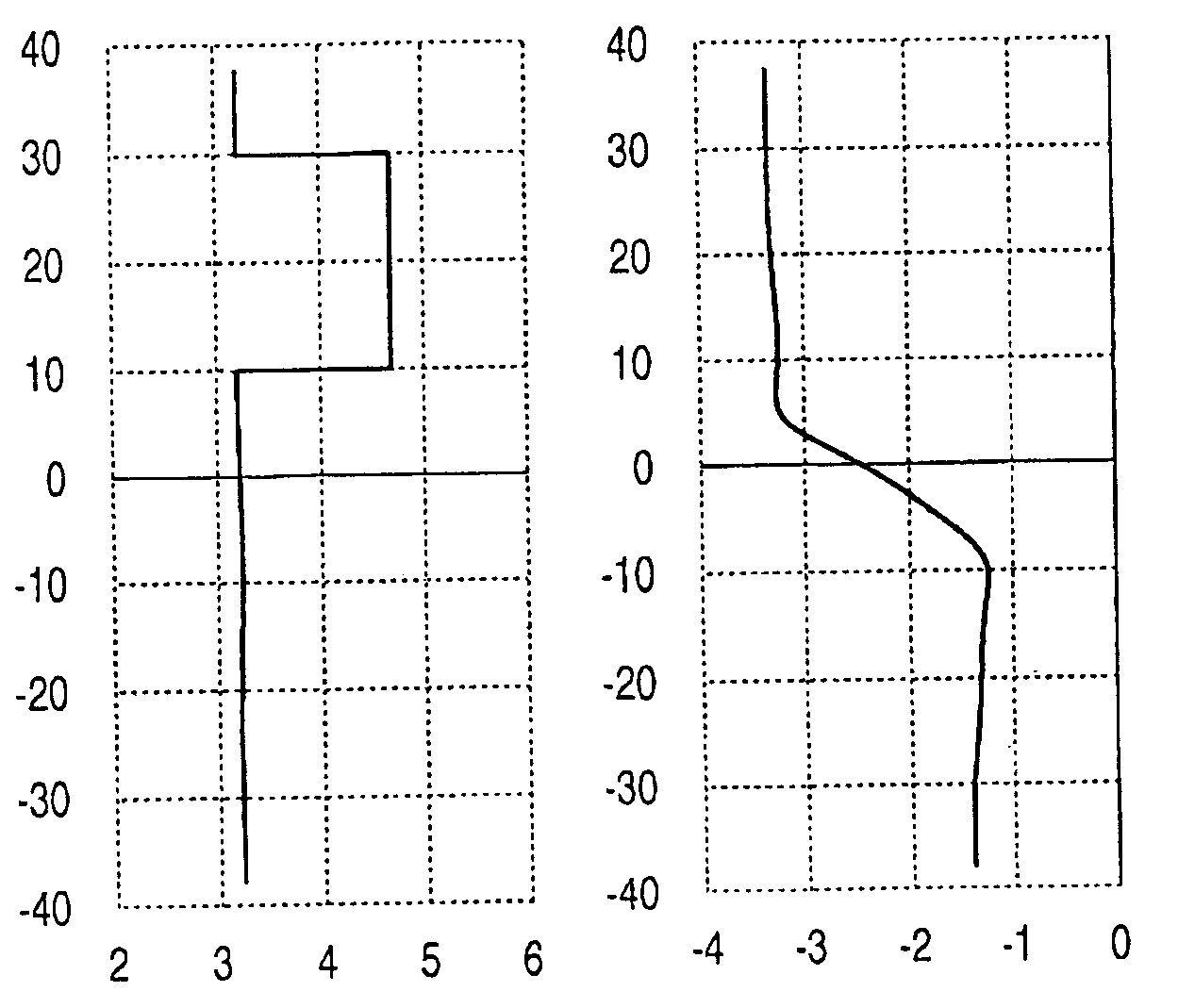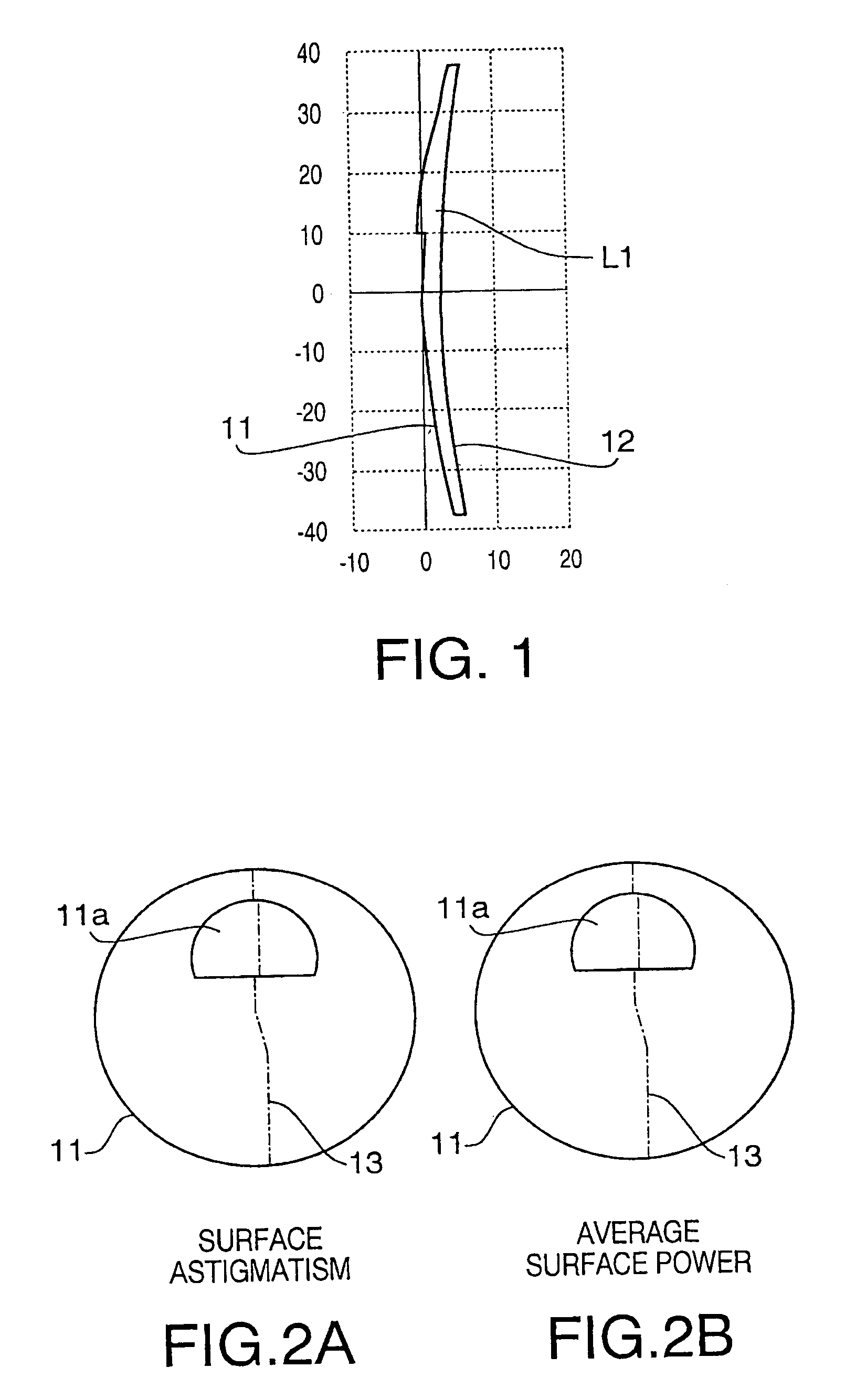Multifocal spectacle lens
a spectacle lens and multi-focal technology, applied in the field of multi-focal spectacle lenses, can solve the problems of front surface of the lens, and limited power at the lower area of the lens, so as to achieve sufficient optical performance and improve workability
- Summary
- Abstract
- Description
- Claims
- Application Information
AI Technical Summary
Benefits of technology
Problems solved by technology
Method used
Image
Examples
first embodiment
[0083]FIG. 1 is a sectional view of a multifocal spectacle lens L1 according to a first embodiment of the present invention. As shown in FIG. 1, the lens L1 has a front surface 11 (an object side) and a back surface 12 (an eye side). The lens L1 is designed to correct middle distance vision and near vision.
[0084]FIG. 2A shows a contour line of surface astigmatism of the front surface 11. FIG. 2B shows a contour line of average surface power of the front surface 11.
[0085]FIG. 3A shows contour lines of surface astigmatism of the back surface 12. FIG. 3B shows contour lines of average surface power of the back surface 12.
[0086]FIG. 4A shows contour lines as to astigmatism of the lens L1 (hereafter, referred to as “transmission astigmatism”). FIG. 4B shows contour lines as to average refractive power of the lens L1 (hereafter, referred to as “average transmission power”).
[0087]In each of FIGS. 2A–4B, an interval between adjacent contour lines corresponds to 0.5 (unit: D), and a chain li...
second embodiment
[0094]FIG. 8 shows a sectional view of a multifocal spectacle lens L2 according to a second embodiment of the present invention. The lens L2 is designed to correct myopia and astigmatism. A shown in FIG. 8, the lens L2 has a front surface 21 and a back surface 22.
[0095]FIG. 9A shows a contour line of surface astigmatism of the front surface 21. FIG. 9B shows a contour line of average surface power of the front surface 21.
[0096]FIG. 10A shows contour lines of surface astigmatism of the back surface 22. FIG. 10B shows contour lines of average surface power of the back surface 22.
[0097]FIG. 11A shows contour lines as to transmission astigmatism of the lens L2. FIG. 11B shows contour lines as to average transmission power of the lens L2.
[0098]In each of FIGS. 9A–11B, an interval between adjacent contour lines corresponds to 0.5 (unit: D), and a chain line 23 represents a fixation line.
[0099]FIG. 12 is a graph showing the average surface power of the front surface 21 along the fixation l...
third embodiment
[0105]FIG. 15 shows a sectional view of a multifocal spectacle lens L3 according to a third embodiment of the present invention. As shown in FIG. 15, the lens L3 has a front surface 31 (an object side) and a back surface 32 (an eye side). The lens L3 is designed to have power to correct hyperopia.
[0106]FIG. 16A shows a contour line of surface astigmatism of the front surface 31. FIG. 16B shows a contour line of average surface power of the front surface 31.
[0107]FIG. 17A shows contour lines of surface astigmatism of the back surface 32. FIG. 17B shows contour lines of average surface power of the back surface 32.
[0108]FIG. 18A shows contour lines as to transmission astigmatism of the lens L3. FIG. 18B shows contour lines as to average transmission power of the lens L3.
[0109]In each of FIGS. 16A–18B, an interval between adjacent contour lines corresponds to 0.5 (unit: D), and a chain line 33 represents a fixation line.
[0110]FIG. 19 is a graph showing the average surface power of the ...
PUM
 Login to View More
Login to View More Abstract
Description
Claims
Application Information
 Login to View More
Login to View More - R&D
- Intellectual Property
- Life Sciences
- Materials
- Tech Scout
- Unparalleled Data Quality
- Higher Quality Content
- 60% Fewer Hallucinations
Browse by: Latest US Patents, China's latest patents, Technical Efficacy Thesaurus, Application Domain, Technology Topic, Popular Technical Reports.
© 2025 PatSnap. All rights reserved.Legal|Privacy policy|Modern Slavery Act Transparency Statement|Sitemap|About US| Contact US: help@patsnap.com



